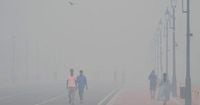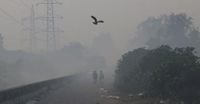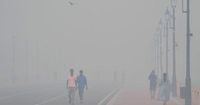On the morning of October 21, 2025, residents across Delhi and the National Capital Region (NCR) awoke to a familiar but no less alarming sight: a thick, gray shroud of smog blanketing the city, reducing visibility to a few hundred meters and casting a pall over historical monuments, bustling streets, and entire neighborhoods. According to the Central Pollution Control Bureau (CPCB), the Air Quality Index (AQI) at 8:00 a.m. stood at a staggering 352—a level officially classified as “very poor” and teetering on the edge of “severe.” For millions in India’s capital, the day after Diwali brought not just the usual post-festival fatigue, but a harsh reminder of the city’s persistent air pollution crisis.
As reported by the Associated Press, the spike in pollution came as no surprise. Diwali, the Hindu festival of lights, is traditionally celebrated with fireworks and firecrackers. This year, despite a yearslong ban on conventional firecrackers, India’s Supreme Court relaxed restrictions to allow the use of so-called “green firecrackers” that purportedly emit 30% fewer pollutants. The court specified that these could be used only during certain hours from October 18 to October 21. Yet, as in previous years, the rule was widely disregarded. Revelers set off firecrackers late into the night, sending plumes of smoke and fine particles into the air, which then mingled with the city’s usual cocktail of emissions and stagnant autumn weather.
By Tuesday morning, the AQI had climbed above 350 in several neighborhoods—a figure that, according to the World Health Organization, is far beyond safe limits and dangerous for everyone, not just those with pre-existing respiratory conditions. In some areas, visibility dropped so low that even New Delhi’s iconic historical sites all but vanished in the haze. “I have never seen anything like this before. We can’t see anything here because of pollution,” Vedant Pachkande, a tourist visiting New Delhi, told the AP.
The annual post-Diwali pollution spike is not a new phenomenon. New Delhi and its metropolitan region, home to more than 30 million people, consistently rank among the world’s most polluted cities—especially in the winter months. The reasons are well documented. As detailed by The New York Times, the city’s air quality nosedives every winter due to a convergence of factors: plummeting temperatures, slower wind speeds, and a host of pollution sources, including vehicles, construction, heavy industry, and the burning of crop residue in neighboring states like Haryana and Punjab. The city’s unique geography doesn’t help either—Delhi sits in a landlocked bowl, surrounded by mountains and plateaus, which traps pollutants and prevents them from dispersing, unlike coastal cities such as Kolkata or Mumbai.
While stubble burning in the agricultural fields of Haryana and Punjab often grabs headlines, emissions studies conducted from 2015 to 2018 suggest it contributes less than 21% of the most harmful particulates. The lion’s share comes from transport, industry, power plants, and construction. Still, northwesterly winds routinely carry smoke from these fires into the capital, compounding the effects of local pollution sources.
The government has not been idle in the face of this challenge. Authorities have implemented a patchwork of emergency measures, including limits on construction activity, restrictions on diesel generator use, and occasional bans on commercial vehicles. The Commission for Air Quality Management has recommended a roadmap involving cleaner fuels, electric mobility, better control of municipal solid-waste burning, and more robust air quality monitoring. Yet, as The New York Times points out, the real obstacle is not a lack of ideas, but poor execution. More than 15 different agencies must coordinate to enforce these measures, and enforcement is often hamstrung by a lack of personnel. For example, in October 2024, only 377 teams were available to enforce the firecracker ban across a city of 20 million people, leading to widespread flouting of the rules.
The issue is further complicated by political rivalry. The national government, led by Prime Minister Narendra Modi’s Bharatiya Janata Party (BJP), and the Delhi regional government, controlled for years by the Aam Aadmi Party, have frequently blamed each other for the crisis. After the BJP took power in Delhi in 2025, Chief Minister Rekha Gupta argued for easing the firecracker ban, citing the importance of tradition, while opposition leaders criticized the government for treating the annual pollution spike as business as usual. Punjab and Haryana, meanwhile, have laws banning stubble burning, but enforcement remains patchy and inconsistent. Persuading farmers to abandon the practice would require substantial subsidies for mechanized alternatives, and the Aam Aadmi Party government in Punjab has accused the BJP of not providing adequate funds.
Meanwhile, the city’s public transport infrastructure lags behind global standards. Delhi has just 45 buses per 100,000 people, about half the figure for London, making it difficult to reduce reliance on private vehicles—a major source of pollution. There have been some improvements: pollutant concentrations have dropped by about 7% in recent years, thanks in part to the adoption of compressed natural gas for public buses and stricter limits on old diesel and gasoline vehicles. But as Shambhavi Shukla of the Center for Science and Environment told The New York Times, “Delhi needs another 60 percent reduction to meet the National Ambient Air Quality Standards.”
The consequences of this persistent smog go beyond immediate health risks. A recent study published in Scientific Reports (part of the Nature Portfolio) found that rising air pollution has led to a steady decline in sunshine hours across most of India. According to Manoj K. Srivastava, a scientist at Banaras Hindu University and one of the study’s authors, this reduction is most pronounced in polluted regions like northern India. The loss of sunlight, Srivastava explained, can affect everything from solar power generation to agricultural productivity, not to mention the local environment and public health.
Despite the scale of the problem, government action has lagged behind rhetoric. In a report filed in Parliament in March, the ministry responsible for pollution control admitted to spending less than 1% of its $100 million budget in 2024. As Shashi Tharoor, an opposition minister, lamented last year, “It is unconscionable that our government has been witnessing this nightmare for years and does nothing about it. Should it even remain the nation’s capital?”
For now, Delhi’s residents are left to cope as best they can—donning masks, running air purifiers, and hoping for a change in the weather. When asked when New Delhi winters might see clean air, former pollution board official Arvind Nautiyal replied, “Please don’t ask me that question. Even the gods will not be able to answer this.”
The post-Diwali haze, then, is more than just a seasonal inconvenience. It is a symptom of deeper systemic failures—of policy, politics, and enforcement—that continue to cloud the future of India’s capital.


